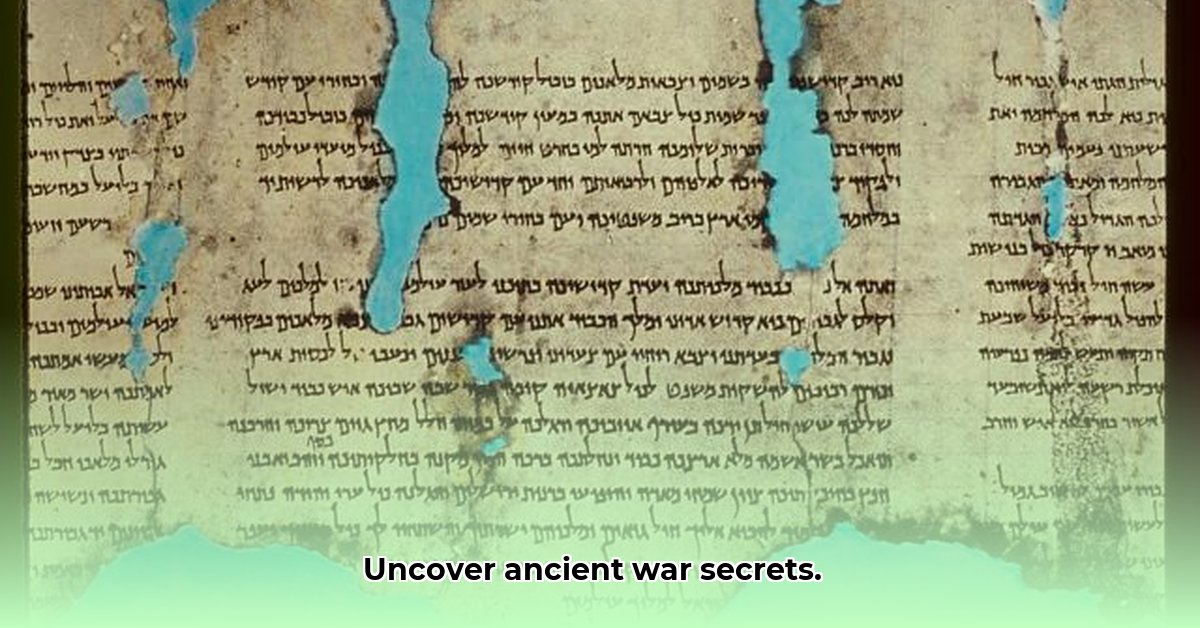
Dead Sea Scrolls War Scroll Analysis: A Glimpse into Ancient Warfare and Apocalyptic Beliefs
Unlocking the secrets of the Dead Sea Scrolls' War Scroll is akin to deciphering a fragmented military manual from a vanished civilization. Discovered in the Qumran Caves near the Dead Sea, this ancient text offers a unique window into the military strategies, beliefs, and worldview of a secretive Jewish sect around 2,000 years ago. But understanding its complexities requires careful scrutiny, balancing exciting discoveries with cautious interpretations. How accurate are the descriptions of ancient weaponry? What was the true nature of the "Sons of Light" and "Sons of Darkness"? Learn more about the Sons of Light and their role. These are just some of the questions that continue to intrigue and challenge scholars today.
Dating the Dead Sea Scrolls War Scroll: A Puzzle in Time
Pinpointing the War Scroll's precise date is a significant challenge. While most scholars agree it originates from the 2nd century BC to the 1st century AD – a period of considerable turmoil in the ancient world – the exact timeframe remains hotly debated. The types of weaponry described provide crucial clues. Some scholars highlight similarities to weaponry from around 150 BC, suggesting an earlier date, while others point to parallels with Roman military organization, arguing for a later composition. This ongoing debate underscores the intricate interpretive work needed to understand this ancient text. What tangible evidence definitively settles the dating question?
Authorship: A Single Mind or a Community Effort?
The question of authorship adds another layer of mystery. Was the War Scroll the painstaking work of a single individual, or the product of a collaborative effort? Some researchers cite the scroll's internal consistency as evidence for a single author meticulously organizing the material. However, the diverse range of topics and potential incorporation of older texts suggest a collaborative process spanning years. This mirrors the collaborative nature of many ancient texts and traditions. Could textual analysis offer a definitive solution to this mystery?
Ancient Warfare: A Detailed Look into Military Tactics
The War Scroll provides astonishingly detailed insights into ancient military practices, resembling a comprehensive army manual detailing troop formations, equipment, and strategies. The famous "seven-stage war against the Kittim" (a term whose identity is still debated) is a prime example of this remarkable military detail. The scroll reveals the community's impressive understanding of warfare, potentially influenced by Hellenistic or Roman military traditions. But were these descriptions purely theoretical exercises, or reflections of real-world combat experience? Did the community actively engage in warfare, or was this a purely imagined scenario?
Fact or Fiction? Separating History from Apocalyptic Visions
The War Scroll presents a compelling blend of historical detail and apocalyptic visions. Some descriptions seem to align with known historical events, while others read like scenes from an apocalyptic narrative. This mixture complicates efforts to assess the scroll's historical accuracy. The inclusion of divine intervention, a protracted forty-year war, and the aforementioned seven-stage war are just a few examples of these complexities. Was the War Scroll intended as a realistic military guide, or a religious vision presented as a military narrative? This question requires a delicate balance between careful scrutiny and interpretative awareness.
The "Sons of Light" and "Sons of Darkness": A Battle of Good and Evil
Central to the War Scroll's narrative is the cosmic struggle between the "Sons of Light" and the "Sons of Darkness." This sharp dichotomy between good and evil underpins the Qumran community's worldview. This theological framework imbues the military descriptions with deeper symbolic meaning. The depicted battles weren't merely physical conflicts but also spiritual ones, reflecting the community's deeply ingrained religious beliefs. Understanding this context is crucial to correctly interpreting the scroll's message. What other religious texts might shed light on this cosmic struggle?
Planning Future Research and Navigating Potential Pitfalls
Future research requires a multi-faceted approach. Scholars must carefully consider the numerous challenges associated with interpreting this ancient document:
Actionable Intelligence: Prioritized Research Areas
- Comparative Analysis: Comparing the scroll's weaponry descriptions with archaeological findings to refine dating methods and enhance understanding of the historical context.
- Intertextual Connections: Investigating links between the War Scroll and other Qumran texts to better understand the community's beliefs and practices.
- Public Engagement: Developing engaging public exhibits and improving digital access to the scroll to increase understanding and promote scholarship.
Risk Assessment Matrix:
Addressing potential pitfalls, such as misinterpreting the scroll's meaning, requires:
- Interdisciplinary Collaboration: Fostering collaborative research across disciplines to avoid misinterpretations.
- Preservation: Implementing robust preservation techniques and controlled access to original materials.
- Open Access: Increasing digitization efforts and supporting open-access initiatives to ensure wider access to the scroll.
Responsible stewardship of the War Scroll is paramount. Ethical considerations and thoughtful access should guide all future research efforts. As research continues, the story revealed by the War Scroll will undoubtedly evolve, potentially reshaping our current understanding of this ancient community and its beliefs.